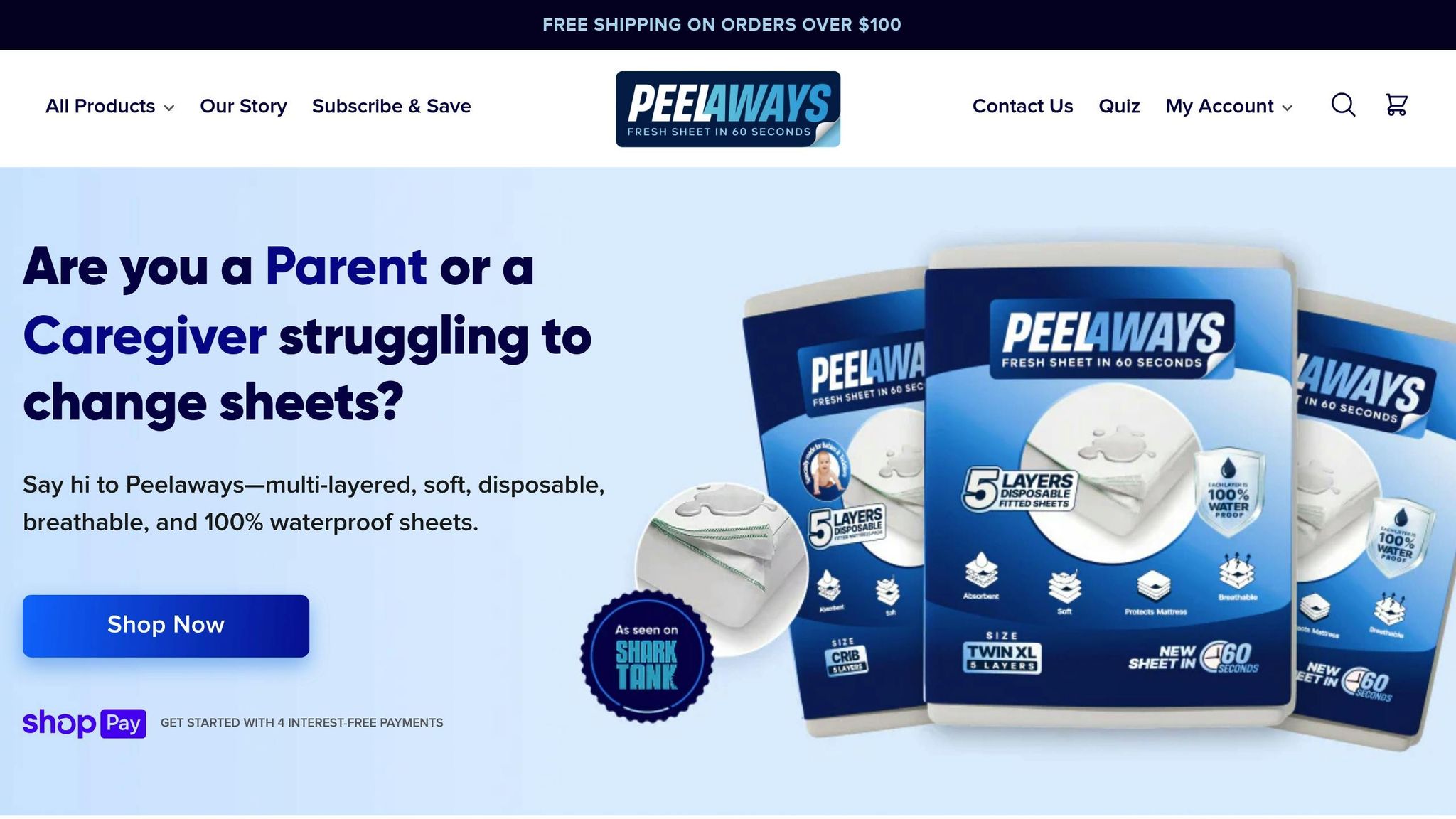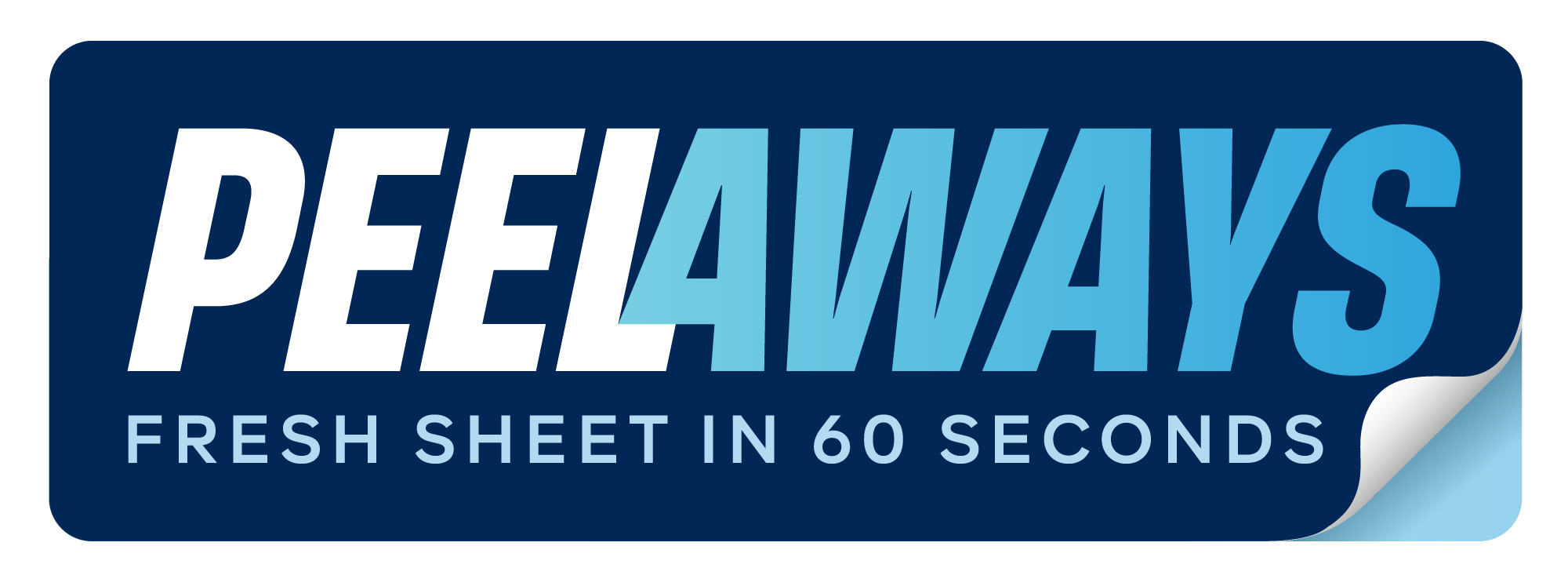How to Replace Sheets on an Occupied Bed

Replacing sheets on an occupied bed is a delicate process that prioritizes cleanliness, patient comfort, and safety. Dirty linens can lead to infections or skin issues, especially for patients with limited mobility. Here’s a quick breakdown of the process:
- Preparation: Gather clean sheets, gloves, laundry bags, and any necessary protective bedding. Adjust the bed to a comfortable working height and explain the procedure to the patient.
- Hygiene: Wash hands, wear gloves, and keep clean and soiled linens separate to prevent cross-contamination.
-
Step-by-Step Process:
- Remove top bedding while keeping the patient covered with a bath blanket.
- Roll the patient gently to one side, replace the soiled sheet with a clean one, and repeat on the other side.
- Replace pillowcases and top sheets, ensuring all linens are smooth and secure.
Using tools like waterproof pads or multi-layer disposable sheets can save time and reduce physical strain. Products like PeelAways allow for quick changes without lifting the patient, making them a convenient option for caregivers managing frequent accidents.
Proper sheet replacement not only ensures hygiene but also helps maintain the patient’s dignity and comfort. By following these steps, caregivers can minimize risks and provide better care.
CNA Skill: Changing an Occupied Bed 🛏️ | Step-by-Step Training
Preparation and Safety Steps
Getting ready for a sheet change involves setting up your workspace and gathering everything you need to ensure the process is smooth and safe for both you and the patient. Taking a few moments to organize beforehand can save time and reduce stress during the procedure.
Gather Your Supplies
Having all your supplies within easy reach is key to avoiding interruptions and ensuring the patient is never left unattended. Here's what you'll need:
- Clean sheets (fitted and flat)
- Pillowcases
- Disposable gloves
- A laundry bag for soiled linens
- Waterproof pads, if necessary
- A slide sheet (also called a draw sheet), if required - this is typically placed under the patient's hips to assist with movement
Unfold the clean sheets and place them on a nearby surface for easy access. Keep the laundry bag and any cleaning supplies close but out of the patient's way to maintain a safe and organized workspace.
Prepare the Bed and Patient
Start by clearing any clutter from around the bed and locking the wheels to prevent unwanted movement. Adjust the bed to a flat, waist-high position to make the process easier and reduce strain on your back.
Remove any personal items from the bedding, like phones or glasses, to keep them safe. Before beginning, explain the procedure to the patient to help ease any anxiety. Close doors or draw curtains to maintain their privacy. If the bed has safety rails and the patient is able, ask them to hold onto a rail for added stability.
For additional safety, raise the side rails on the side where you’ll roll the patient to prevent falls. If the bed doesn’t have rails and you’re working alone, consider asking someone to assist until you’re confident handling the task on your own.
Infection Control Steps
Maintaining good hygiene throughout the process is essential to protect both you and the patient from cross-contamination. Start by thoroughly washing your hands and putting on a fresh pair of disposable gloves.
Keep soiled and clean linens separate at all times. As soon as you remove any soiled sheets, place them directly into the laundry bag - don’t leave them on furniture or the floor. If disposable pads become soiled, dispose of them immediately.
If the sheet you’re rolling toward the patient has any soiled areas, either clean it or cover the spot with a clean towel to stop contamination from spreading. Once the sheet change is finished, remove your gloves and wash your hands again to ensure you don’t carry any contaminants away from the bedside. Following these steps will help keep the environment clean and safe for everyone involved.
Step-by-Step Sheet Replacement Process
Now that your workspace is ready and your supplies are within reach, it’s time to start replacing the sheets. This process requires a steady hand and careful attention to keep your patient comfortable while maintaining safety and hygiene. Following these steps will help ensure both cleanliness and patient well-being.
Remove Top Bedding
Start by explaining the process to your patient to help ease any anxiety and maintain their dignity. Gently remove any blankets, checking for personal items like glasses, hearing aids, or jewelry that may be hidden in the bedding [3].
As you remove the top sheet, cover the patient with a bath blanket to keep them warm and maintain privacy [2][3][4]. If the blankets are clean and can be reused, place them on a nearby chair. Any soiled bedding should go directly into a laundry bag to avoid spreading germs [2].
Work at a calm and steady pace - sudden movements can be unsettling, especially for patients with limited mobility or medical sensitivities. With the top bedding removed, you can move on to replacing the bottom sheet.
Roll and Replace Bottom Sheets
Carefully roll the patient onto one side, supporting their head, shoulders, and hips. If possible, encourage them to hold onto the bed rail for added stability [3].
Once they are positioned, loosen the fitted sheet from the exposed side of the mattress. Roll the soiled sheet toward the center of the bed, tucking it snugly against the patient’s back. This keeps the dirty linen contained and creates a clean workspace.
Next, take a clean fitted sheet and place it on the exposed half of the mattress. Smooth out any wrinkles and secure the sheet tightly to prevent pressure points [2][4].
Gently roll the patient over the bundled soiled sheet onto the clean sheet, providing support as needed. Once they are on the clean side, remove the soiled sheet and place it directly into the laundry bag. Finally, secure the clean sheet on the remaining side of the mattress, pulling it taut and tucking the corners under to ensure a smooth surface.
With the clean sheet in place, reposition your patient comfortably, and move on to the final steps.
Complete the Process
Support the patient’s head as you remove the old pillowcase and slide on a fresh one. Fluff the pillow for added comfort before placing it back under their head. Ensure the patient is centered on the bed and lying straight, with no part of their body pressing against hard surfaces like bed rails.
Replace the top sheet and blankets, tucking them loosely at the foot of the bed to allow for easy movement and proper circulation. Make sure the covers reach up to the patient’s shoulders to keep them warm [2][3].
Smooth out any wrinkles in the bedding and check with the patient to see if they need any adjustments to their position or pillows. Ensure their personal items are within easy reach, and you’re all set!
sbb-itb-45288fe
Advanced Bedding Solutions for Caregivers
Modern caregiving demands tools that make life easier for both caregivers and patients. Advanced bedding solutions are designed to reduce physical strain, save time, and improve patient comfort. These innovations fit seamlessly into care routines, helping caregivers provide efficient and compassionate support.
Why Waterproof and Disposable Bedding Matters
Waterproof pads and draw sheets act as a barrier, keeping moisture away from the mattress. This not only protects the mattress itself but also helps prevent bacterial growth that can lead to skin irritations or infections. For patients, especially those with sensitive skin or mobility challenges, this layer of protection is essential.
Disposable bedding adds another layer of convenience, cutting down on laundry and reducing the risk of cross-contamination. Instead of managing piles of soiled linens, caregivers can simply discard the used layers. This is especially helpful for individuals who are immunocompromised, elderly, or have special needs.
Changing traditional sheets can be a time-consuming process, often requiring multiple steps like gathering supplies and carefully moving the patient. Multi-layer disposable sheets simplify this process. When the top layer is soiled, you simply peel it away to reveal a fresh, clean surface underneath. Products like PeelAways make this process quick and efficient, saving time and effort.
PeelAways: A Game-Changer for Caregivers

PeelAways offers a patented multi-layer sheet design that makes changing bedding on an occupied bed quick and easy. Each fitted sheet comes with 5 to 7 layers, depending on the size, with options like Twin XL and Cot sizes offering up to 7 layers for extended use.
The process is simple: peel away the soiled layer in under a minute - no need to lift the mattress, reposition the patient, or deal with laundry.
"I couldn't believe these would be waterproof from accidents because the linings were so thin, but was I wrong. They do not seep through to the next liner and are so much easier to use than changing sheets every day for the elderly." – Linda [1]
Each layer is soft, breathable, and noiseless, ensuring patient comfort. They’re also free from harsh chemicals like vinyl, PVC, phthalates, and fire retardants, making them safe for sensitive skin.
Caregivers frequently praise the impact PeelAways has on their routines. Families managing incontinence report fewer laundry loads and reduced stress. The product range covers all bed sizes, from Crib-A-Peel to King size, with prices ranging from $30.99 to $53.99.
For those caring for elderly or special-needs patients, maintaining dignity is crucial. PeelAways can be discreetly placed under regular bedding, allowing for quick changes that help preserve privacy and comfort during accidents.
With over 6,000 five-star reviews and an average rating of 4.8 out of 5 stars, PeelAways has become a trusted solution for caregivers in various situations, from post-surgery recovery to long-term care. The company also offers gift cards, making it easy for loved ones to provide practical support to caregivers.
Comfort, Hygiene, and Accident Prevention
Building on the sheet replacement methods discussed earlier, let’s shift focus to practical ways to enhance patient comfort and prevent accidents during this process.
Keep Patients Comfortable During Changes
When changing sheets, always prioritize the patient’s comfort. Use slow, gentle movements to minimize discomfort, especially for individuals with limited mobility or chronic pain. Supporting joints and pressure points with pillows or rolled towels can help keep the patient stable and at ease.
To maintain warmth and privacy, drape the patient with a bath blanket throughout the process. Explain each step as you go, even if the patient seems unresponsive - this helps reduce anxiety and preserve their dignity.
Pay close attention to pressure points like the heels, sacrum, elbows, and shoulders. These areas are particularly prone to pressure ulcers, which affect about 2.5 million patients annually in the United States, according to the CDC [5]. Watch for redness, swelling, or skin irritation, and take action if needed. Reposition the patient to relieve pressure, add cushioning, and apply barrier creams if recommended. Document any concerns for follow-up with medical staff. Comfort isn’t just about dignity - it’s also a key step in accident prevention.
Hygiene Best Practices
Maintaining hygiene is critical throughout the sheet-changing process. Clean any soiled areas immediately using warm water and mild detergent, then dry the skin thoroughly to prevent moisture-related issues like bacterial growth or skin breakdown.
Avoid shaking or fluffing linens, as this can spread contaminants into the air. Keep soiled linens separate from clean ones, and ensure proper disposal or storage to reduce the risk of cross-contamination.
Inspect bedding regularly for signs of moisture or soiling, not just during scheduled changes. Sheets and protective layers should be replaced immediately if they become wet or dirty. For patients with limited mobility, aim to change sheets every 2–3 days, or more frequently for those with incontinence or wounds.
Waterproof and disposable bedding can be a game-changer in long-term care settings. These materials create a moisture barrier that protects the mattress while still offering a breathable surface for comfort, helping to lower infection risks.
How to Prevent Accidents
Accident prevention goes hand in hand with maintaining hygiene. Use protective bedding proactively, rather than waiting for an incident to occur. Products like PeelAways (https://peelaways.com) offer a practical solution - multi-layer disposable sheets that allow you to quickly peel away a soiled layer to reveal a clean surface, minimizing disturbance to the patient.
Once the sheets are in place, smooth out any wrinkles. Wrinkles can increase the risk of pressure sores, so ensuring the sheets are properly fitted is essential for both comfort and safety.
Routine maintenance is another critical step. Even if protective layers appear clean, replace them every 7–10 days to prevent the buildup of microscopic contaminants. This proactive approach helps maintain hygiene and prevents minor issues from escalating.
Finally, after completing the sheet change, position the call light within the patient’s reach and check their preferred bed position. This small but crucial step ensures they can easily communicate any discomfort or needs, reducing the risk of delays in care.
Key Takeaways for Caregivers
Replacing bed sheets efficiently starts with good preparation, minimizing unnecessary movement, and maintaining clear communication. Always prioritize safety by using bed rails and seeking assistance when needed. Explaining each step to the patient helps preserve their dignity and comfort throughout the process.
The process is straightforward: remove the top bedding, gently roll the patient to replace sections of the sheet, and ensure the patient stays covered to maintain warmth and respect. Following proper linen handling practices and maintaining good hand hygiene can significantly reduce healthcare-associated infections - by as much as 30% in care settings [3].
For caregivers looking to save time and reduce physical strain, advanced bedding solutions can make a big difference. Products like PeelAways (https://peelaways.com) offer multi-layer disposable sheets that simplify the process. These sheets allow you to change a soiled layer in under a minute - no need to lift the patient or strip the entire bed. Each layer is 100% waterproof to prevent cross-contamination while remaining breathable for the patient’s comfort.
"It is more convenient to use than sheets, less washing, just peel off soiled layer and throw out."
- Kalahiki Jr Samuel [1]
Managing time and stress is vital for caregivers, especially in long-term care. Solutions like these reduce the burden of constant laundry and ease the physical demands of caregiving. With options available for all bed sizes, these tools empower caregivers to perform sheet changes more efficiently while enhancing the overall quality of patient care.
FAQs
How can I safely and comfortably change sheets on a bed while it's occupied?
To change sheets on an occupied bed with care and ease, it's important to focus on reducing movement and keeping the person as comfortable as possible during the process. Peelaways disposable sheets simplify this task with their multi-layered, waterproof design. Instead of lifting the mattress or disturbing the person in bed, you can just peel away the top, soiled layer to reveal a fresh, clean one underneath.
This simple method not only makes the process quicker but also helps reduce stress for both the caregiver and the individual. It ensures hygiene is maintained and minimizes the risk of cross-contamination. Highly favored by caregivers, Peelaways offer a practical option for elder care, post-surgery recovery, and similar situations.
What’s the best way for caregivers to maintain hygiene and prevent infections when changing sheets on an occupied bed?
Caregivers looking for an easy way to maintain hygiene and reduce the risk of infections can rely on Peelaways disposable bed sheets. These sheets come with a clever multi-layered design that lets you peel off the top layer when it’s soiled, instantly revealing a fresh, clean layer underneath. No need to lift the mattress or deal with piles of laundry, making the process quicker and more hygienic.
Peelaways are a game-changer for elder care, post-surgery recovery, or any scenario where sheets need frequent changing. With waterproof and absorbent layers, they not only keep things clean but also ensure comfort for the user, simplifying hygiene without compromising on practicality.
What are the advantages of using Peelaways disposable bed sheets for caregivers and patients?
Peelaways disposable bed sheets offer a convenient and sanitary option for caregivers and patients alike. These sheets are designed with multiple layers, so you can simply peel off the soiled top layer in seconds to reveal a fresh, clean sheet beneath - no need to wrestle with lifting mattresses or dealing with piles of laundry.
Crafted from soft, breathable, and 100% waterproof materials, Peelaways provide both comfort and mattress protection. They come in a range of sizes, including Crib, Cot, Twin, Twin XL, Full, Queen, and King, making them versatile for various needs. Whether it’s elder care, medical recovery, potty training, or other situations, Peelaways make bed care easier and help maintain better hygiene. Caregivers and families alike appreciate how these sheets simplify their routines.
Related Blog Posts
- Bedding Care Checklist for Healthcare Facilities
- How Disposable Sheets Reduce Cross-Contamination
- FAQs About Anti-Slip Bedding for Patients
- Common Bedding Problems in Elderly Care
Comments
0

SAVE MONEY & WATER
Professionals & Institutions save a fortune on labor/laundry.

SUPERIOR COMFORT
The first thing our customers notice is how soft our sheets are.

100% WATERPROOF
Each layer is 100% Waterproof, perfect for spills and accidents

SAVE TIME
Change the sheet in under 1 minute without stripping the bed.




Leave a comment